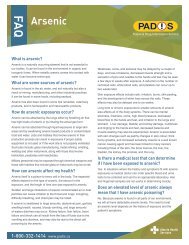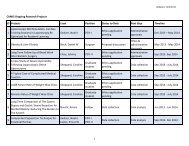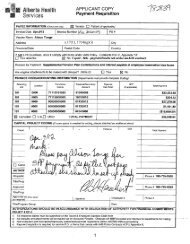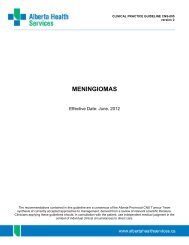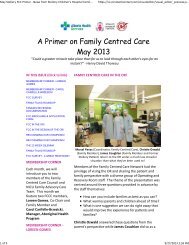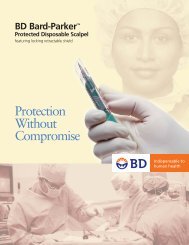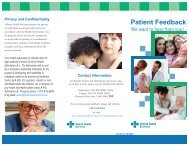EXTRAGONADAL GERM CELL TUMOURS - Alberta Health Services
EXTRAGONADAL GERM CELL TUMOURS - Alberta Health Services
EXTRAGONADAL GERM CELL TUMOURS - Alberta Health Services
Create successful ePaper yourself
Turn your PDF publications into a flip-book with our unique Google optimized e-Paper software.
CLINICAL PRACTICE GUIDELINE GU-007<br />
Version 1<br />
<strong>EXTRAGONADAL</strong> <strong>GERM</strong> <strong>CELL</strong> <strong>TUMOURS</strong><br />
Effective Date: April 2013<br />
The recommendations contained in this guideline are a consensus of the <strong>Alberta</strong> Provincial Genitourinary Tumour<br />
Team synthesis of currently accepted approaches to management, derived from a review of relevant scientific<br />
literature. Clinicians applying these guidelines should, in consultation with the patient, use independent medical<br />
judgment in the context of individual clinical circumstances to direct care.
BACKGROUND<br />
CLINICAL PRACTICE GUIDELINE GU-007<br />
Version 1<br />
Germ cell tumours (GCTs) are one of the most common cancers among young adult men. 1 An<br />
extragonadal GCT is, by definition, a germ cell neoplasm displaying one of the histologies associated with<br />
gonadal origin, but located outside the gonads. 2 Extragonadal GCTs are relatively uncommon, but<br />
represent 1 to 5% of all GCTs. 3 Non-central nervous system extragonadal GCTs are found in a variety of<br />
anatomic locations, but most commonly affect the mediastinum and retroperitoneal. 2<br />
The mediastinum is the most common anatomic site for extragonadal germ cell tumours in adults. 3 Data<br />
on GCT etiology suggest that mediastinal GCTs comprise approximately 54% of all extragonadal GCT<br />
cases, while retroperitoneal GCTs comprise the remaining 45%. 4-6 The majority of these cases occur in<br />
males aged 20 to 40 years. 7 When treated with induction chemotherapy, with or without secondary<br />
surgery, patients with pure seminomatous extragonadal GCTs have a long term cure rate of almost 90%,<br />
irrespective of the primary tumour site. Patients with mediastinal non-seminoma have a five-year survival<br />
rate of 45%, whereas patients with retroperitoneal primaries have a five-year survival rte of 62%. 8<br />
GUIDELINE QUESTION<br />
What are the appropriate management strategies for patients with primary mediastinal or retroperitoneal<br />
germ cell tumours?<br />
DEVELOPMENT AND REVISION HISTORY<br />
This guideline was reviewed and endorsed by the <strong>Alberta</strong> Provincial Genitourinary Tumour Team.<br />
Members of the <strong>Alberta</strong> Provincial Genitourinary Tumour Team include medical oncologists, radiation<br />
oncologists, urologists, pathologists, nurses, and pharmacists. Evidence was selected and reviewed by a<br />
working group comprised of members from the <strong>Alberta</strong> Provincial Genitourinary Tumour Team and a<br />
Knowledge Management Specialist from the Guideline Utilization Resource Unit. A detailed description of<br />
the methodology followed during the guideline development process can be found in the Guideline<br />
Utilization Resource Unit Handbook.<br />
SEARCH STRATEGY<br />
The Pubmed database was searched using the terms (retroperitoneal OR mediastinal) AND germ cell<br />
AND primary, published between 1946 and 2012 April. Results were limited to clinical trials, studies in<br />
humans, meta-analyses, and practice guidelines. The Medline database was then searched for relevant<br />
literature using the MeSH terms “Neoplasm, germ cell and embryonal” with subheadings drug therapy,<br />
radiotherapy, therapy, and surgery, combined with “extragonadal.” Results were limited to literature<br />
published between 1946 and 2012 April. Studies involving fewer than ten patients with extragonadal germ<br />
cell tumours, as well as single case studies, were excluded.<br />
Websites of the following guideline developers were searched for relevant guidelines: National<br />
Comprehensive Cancer Network (NCCN), British Columbia Cancer Agency (BCCA), European Society of<br />
Medical Oncology (ESMO), National Institutes of <strong>Health</strong> and Clinical Excellence (NICE), American Society<br />
of Clinical Oncology (ASCO), Scottish Intercollegial Guidelines Network (SIGN), Cancer Council Australia<br />
(CCA) and Cancer Care Ontario (CCO).<br />
Page 2 of 8
TARGET POPULATION<br />
CLINICAL PRACTICE GUIDELINE GU-007<br />
Version 1<br />
These recommendations apply to postpubertal patients with primary mediastinal or retroperitoneal germ<br />
cell tumours.<br />
RECOMMENDATIONS<br />
Diagnosis:<br />
• If a patient presents with undifferentiated adenocarcinoma of unknown origin, copy number of<br />
chromosome i12p should be performed.<br />
• Lactate dehydrogenase (LDH), alpha fetoprotein (AFP) and gonadotropin (hCG) should be assessed.<br />
• Patients should be classified and treated based on prognosis: 1<br />
Table 1. Prognostic factors for germ cell tumours.<br />
Prognosis Non-seminoma Seminoma<br />
good Primary extragonadal retroperitoneal<br />
Any primary localization<br />
and low markers: AFP
CLINICAL PRACTICE GUIDELINE GU-007<br />
Version 1<br />
5. Patients with mediastinal GCTs who relapse have poor prognosis. Transplant should not routinely be<br />
offered to these patients. However, depending on the results from salvage chemotherapy, patient<br />
performance status, individual factors and patient’s desire to pursue the transplant, it may be<br />
considered only after an honest discussion between the clinician and patient as the chance of long<br />
term remission and cure are very low.<br />
6. After the completion of chemotherapy, strong consideration for retroperitoneal lymph node dissection<br />
should be given in those patients with retroperitoneal primary GCTs.<br />
7. After the completion of chemotherapy, surgery to resect any residual masses should be strongly<br />
considered in those patients with mediastinal primary GCTs.<br />
Table 2. Suggested follow up schedule for germ cell tumours. 9<br />
Group<br />
Clinical examination and<br />
diagnostics<br />
Year 1<br />
Frequency of exam (months)<br />
Year 2 Year 3 Year 4 Year 5 Year 5-10<br />
LDH, AFP, HCG, clinical exam<br />
3 3 3 3 3 6<br />
good<br />
prognosis<br />
X-ray of the chest or CT scan of<br />
chest (if supradiaph. disease)<br />
3-6* 4 6 6 6<br />
CT scan of the abdomen/pelvis<br />
3 4 6 6 6<br />
LDH, AFP, HCG, clinical exam<br />
3 3 3 3 3 6<br />
intermediate<br />
and poor<br />
prognosis<br />
X-ray of the chest or CT scan of<br />
chest (if supradiaph. disease)<br />
CT scan of the abdomen/pelvis<br />
3-6*<br />
3<br />
3-6*<br />
3<br />
4-6*<br />
4<br />
6<br />
6<br />
6<br />
6<br />
* depending on the presence of intrathoracic disease<br />
DISCUSSION<br />
Diagnosis<br />
Data from an international series of 635 patients with extragonadal GCTs (54% had mediastinal primary<br />
GCTs and 45% had retroperitoneal primary GCTs) who were treated from 1975 to 1996 at 11 cancer<br />
centers was analyzed. 5 The most common symptoms at initial presentation in patients with mediastinal<br />
GCTs included dyspnea (25%), chest pain (23%) and cough (17%), fever (13%), weight loss (11%), vena<br />
cava occlusion syndrome and fatigue or weakness (6%). For patients with retroperitoneal primary GCTs,<br />
most common symptoms were abdominal-related (29%) and back pain (14%), followed by weight loss<br />
(9%), fever (8%), and vena cava or other thrombosis (9%). 2,5 Around 50-75% of patients with nonseminoma<br />
extragonadal GCTs have elevated AFP and iso-chromosome i12p. 5,6,10 Approximately 40% of<br />
patients with mediastinal seminoma and non-seminoma and those with retroperitoneal seminoma have<br />
elevated hCG. 5,6 A higher average percentage (about 70%) of patients with retroperitoneal non-seminoma<br />
present with elevated hCG levels. 6 Patients should be classified and treated based on prognosis. 1<br />
Management<br />
Chemotherapy<br />
All patients presenting with extragonadal germ cell tumours should be considered for enrollment in clinical<br />
trials. Bleomycin, etoposide and cisplatin (BEP) or etoposide, ifosfamide, cisplatin (VIP) is recommended<br />
as first-line chemotherapy, with the number of cycles given based on risk category. The recommendation<br />
Page 4 of 8
CLINICAL PRACTICE GUIDELINE GU-007<br />
Version 1<br />
is in line with that of other guidelines and reviews. 2,9,11,12 VIP should be considered for those patients who<br />
cannot tolerate bleomycin. A phase III trial by Motzer et al. (2007) randomized patients to receive either 4<br />
cycles of BEP or 2 cycles of BEP followed by 2 cycles of cisplatin, etoposide, cyclophosphamide (CECP)<br />
and stem cell transplant. Of the 219 patients included in this study, 11 had retroperitoneal primary GCTs<br />
and 58 had mediastinal primary GCTs. Complete response to treatment was similar between the two<br />
groups (55% for BEP versus 56% for CECP), as was 2-year overall survival (72% for BEP versus 71% for<br />
CECP). However, gastrointestinal and hepatobiliary toxicity was lower in the BEP group (19% versus 42%<br />
and 9% versus 24%, respectively). 13<br />
Nichols et al. (1998) conducted a randomized trial of 304 patients with advanced, disseminated germ cell<br />
tumours. Patients received either four cycles of BEP or VIP. Complete remission rate (37% VIP versus<br />
31% BEP) and 2-year overall survival rate (74% VIP and 71% BEP) were not significantly different.<br />
However, the use of ifosfamide instead of bleomycin led to significantly higher genitourinary and<br />
hematologic toxicity. 14 The final analysis of Eastern Cooperative Oncology Group protocol E3887 had<br />
similar results. After a median follow-up of 7.3 years, patients had similar progression free survival and<br />
overall survival rates. For patients treated with BEP, overall survival was 57% and progression free<br />
survival 49%, versus 62% and 56% in patients treated with VIP. Hematologic toxicity was greater in the<br />
ifosfamide arm in this study as well. 15<br />
For failure or relapse on either of these regimens and good risk disease, high dose chemotherapy (HDCT)<br />
and peripheral blood stem cell transplantation can be given. Recommended agents for HDCT include<br />
ifosfamide, vinblastine, carboplatin, etoposide and paclitaxel. Patients who are classified as poor risk at<br />
relapse should be considered early for HDCT and peripheral blood stem cell transplantation, as they may<br />
not be well enough to consider this treatment in the third line setting. Hartmann et al. (2001) conducted a<br />
multi-centre retrospective review of 142 patients with relapsed non-seminomatous extragonadal germ cell<br />
tumours who received platinum-based chemotherapy as first-line treatment. Patients were treated at<br />
relapse with combinations of cisplatin, ifosfamide, vinblastine, etoposide, carboplatin and paclitaxel, and<br />
34% of patients were treated with HDCT followed by autologous bone marrow transplantation. 16 At 45<br />
months follow-up, 19% of patients (n=27) were alive without evidence of disease; 17 of those were treated<br />
at relapse with conventional chemotherapy and 10 were treated with HDCT. For patients with<br />
retroperitoneal primaries, 32% and 12% of those with mediastinal primaries treated with HDCT achieved<br />
were alive without any evidence of disease at 45 months. Of these patients, 44% of them also received<br />
surgery post-HDCT. 16<br />
A randomized phase III trial of 280 patients with relapsed poor prognosis GCTs compared 4 cycles of<br />
cisplatin, ifosfamide, and etoposide (A) with 3 cycles followed by HDCT with etoposide, carboplatin and<br />
cyclophosphamide and haematopoietic stem cell support (B). No significant improvements in the HDCT<br />
group were observed in regards to 3- year event free survival (35% versus 42%, p=0.16) or overall<br />
survival (53% versus 59%). 17 Feldman et al. (2010) reported the outcomes of 107 patients with poor<br />
prognosis GCTs (such as those with extragonadal primaries) who failed first line chemotherapy and were<br />
subsequently treated with paclitaxel and ifosfamide, followed by high-dose carboplatin and etoposide (TI-<br />
CE) with stem cell transplant. Five-year disease free survival was 47% for these patients, and OS was<br />
52% (median follow-up 61 months). 18 Lorch et al. (2010) conducted a trial of HDCT in late relapse GCTs,<br />
defined as relapse after 2 years from completion of cisplatin-based chemotherapy. Patients were treated<br />
with HDCT followed by resection where possible. At a median follow-up of 5.6 years, 14% of patients had<br />
no evidence of disease progression. 19<br />
Page 5 of 8
CLINICAL PRACTICE GUIDELINE GU-007<br />
Version 1<br />
Patients with mediastinal GCTs who relapse have poor prognosis. Transplant should not routinely be<br />
offered to these patients. However, depending on the results from salvage chemotherapy, patient<br />
performance status, individual factors and patient’s desire to pursue the transplant, it may be considered<br />
only after an honest discussion between the clinician and patient as the chance of long term remission and<br />
cure are very low. Hidlago et al. (1997) looked specifically at patients with mediastinal non-seminoma<br />
treated with cisplatin-based chemotherapy and considered for residual mass resection in their<br />
retrospective review of patient records. Fifteen patients had disease confined to the mediastinum, and 12<br />
had metastatic disease. Eleven patients (40.7%) became disease free with initial treatment; 4 of these<br />
patients had received only platinum-based chemotherapy, 1 surgery followed by adjuvant chemotherapy,<br />
and 6 chemotherapy followed by surgery. The remaining patients had only partial or no response to initial<br />
treatment, and 11 received salvage treatment to which none responded. This led the authors to conclude<br />
that in the case of mediastinal non-seminoma, the achievements of a disease-free status after initial<br />
treatment are likely to be cured. 20<br />
Surgery in extragonadal GCTs<br />
In retroperitoneal germ cell tumours, strong consideration for retroperitoneal lymph node dissection should<br />
be given after the completion of chemotherapy (recommendation #6). Consideration should also be given<br />
to the resection of any residual masses in mediastinal primary GCTs (recommendation #7).<br />
Gerl et al. (1996) reviewed the medical records of 51 patients with extragonadal germ cell tumours (n=35<br />
retroperitoneal primary, n=16 mediastinal primary) treated with platinum-based chemotherapy and<br />
surgery. Thirty five patients had seminoma, and the remaining 16 non-seminoma. Fifty percent of patients<br />
with mediastinal primary non seminoma had no evidence of disease at a median of 96 months, whereas<br />
65% of patients with retroperitoneal non seminoma had no evidence of disease at a median of 39 months.<br />
Those patients with seminoma extragonadal tumours survived with no evidence of disease constituted<br />
96% of all seminoma patients at a median of 66 months. 21 Goss et al. (1994) documented their 14 year<br />
experience treating a total of 40 patients with extragonadal GCTs at 4 University of Toronto teaching<br />
hospitals. After combined modality therapy, 53% of mediastinal non seminomas achieved complete<br />
remission at a median 70 months, whereas 88% of mediastinal seminomas survived with no evidence of<br />
disease at a median 45 months. 22<br />
Kesler et al. (2008) reported a 25-year single institution experience of post-chemotherapy surgery for 158<br />
patients with mediastinal primary non-seminoma GCTs. Intra-operative deaths occurred in 6% of patients,<br />
90% of which were due to respiratory failure. Post-operative complications occurred in 18% of patients.<br />
Interestingly, none of the patients that received a chemotherapy regimen containing bleomycin had<br />
respiratory complications during or after surgery. 23 A retrospective study of 75 patients with primary<br />
mediastinal non-seminomatous GCTs was conducted by Ganjoo et al. (2000). All patients received<br />
platinum-based chemotherapy, and 62 (83%) underwent post-chemotherapy resection. Postchemotherapy<br />
pathology was found in both a multivariate and univariate analysis to be the most important<br />
predictor of survival (p
GLOSSARY OF ABBREVIATIONS<br />
Acronym Description<br />
AFP alpha fetoprotein<br />
BEP bleomycin, etoposide, cisplatin<br />
GCT germ cell tumour<br />
hCG gonadotropin<br />
HDCT high dose chemotherapy<br />
LDH lactate dehydrogenase<br />
TI-CE paclitaxel, ifosfamide, cisplatin, etoposide<br />
VIP etoposide, ifosfamide, cisplatin<br />
DISSEMINATION<br />
CLINICAL PRACTICE GUIDELINE GU-007<br />
Version 1<br />
• Present the guideline at the local and provincial tumour team meetings and weekly rounds.<br />
• Post the guideline on the <strong>Alberta</strong> <strong>Health</strong> <strong>Services</strong> website.<br />
• Send an electronic notification of the new guideline to all members of AHS, Cancer Care.<br />
MAINTENANCE<br />
A formal review of the guideline will be conducted at the Annual Provincial Meeting in 2015. If critical new<br />
evidence is brought forward before that time, however, the guideline working group members will revise<br />
and update the document accordingly.<br />
CONFLICT OF INTEREST<br />
Participation of members of the <strong>Alberta</strong> Provincial Genitourinary Tumour Team in the development of this<br />
guideline has been voluntary and the authors have not been remunerated for their contributions. There<br />
was no direct industry involvement in the development or dissemination of this guideline. <strong>Alberta</strong> <strong>Health</strong><br />
<strong>Services</strong> – Cancer Care recognizes that although industry support of research, education and other areas<br />
is necessary in order to advance patient care, such support may lead to potential conflicts of<br />
interest. Some members of the <strong>Alberta</strong> Provincial Genitourinary Tumour Team are involved in research<br />
funded by industry or have other such potential conflicts of interest. However the developers of<br />
this guideline are satisfied it was developed in an unbiased manner.<br />
REFERENCES<br />
1. International Germ Cell Consensus Classification: a prognostic factor-based staging system for metastatic germ<br />
cell cancers. International Germ Cell Cancer Collaborative Group. J Clin Oncol 1997 Feb;15(2):594-603.<br />
2. Schmoll HJ. Extragonadal germ cell tumors. Ann Oncol 2002;13 Suppl 4:265-272.<br />
3. McKenney JK, Heerema-McKenney A, Rouse RV. Extragonadal germ cell tumors: a review with emphasis on<br />
pathologic features, clinical prognostic variables, and differential diagnostic considerations. Adv Anat Pathol 2007<br />
Mar;14(2):69-92.<br />
4. Bokemeyer C, Droz JP, Horwich A, Gerl A, Fossa SD, Beyer J, et al. Extragonadal seminoma: an international<br />
multicenter analysis of prognostic factors and long term treatment outcome. Cancer 2001 Apr 1;91(7):1394-1401.<br />
5. Bokemeyer C, Nichols CR, Droz JP, Schmoll HJ, Horwich A, Gerl A, et al. Extragonadal germ cell tumors of the<br />
mediastinum and retroperitoneum: results from an international analysis. J Clin Oncol 2002 Apr 1;20(7):1864-73.<br />
Page 7 of 8
CLINICAL PRACTICE GUIDELINE GU-007<br />
Version 1<br />
6. Mizushima Y. Extragonadal germ cell tumors. Intern Med 2004 Dec;43(12):1099-1100.<br />
7. Kesler KA, Einhorn LH. Multimodality treatment of germ cell tumors of the mediastinum. Thorac Surg Clin 2009<br />
Feb;19(1):63-69.<br />
8. Bokemeyer C, Hartmann JT, Fossa SD, Droz JP, Schmol HJ, Horwich A, et al. Extragonadal germ cell tumors:<br />
relation to testicular neoplasia and management options. APMIS 2003 Jan;111(1):49-59; discussion 59-63.<br />
9. British Columbia Cancer Agency. Testis. Cancer Management Guidelines- Genitourinary June 2005.<br />
10. Bosl GJ, Ilson DH, Rodriguez E, Motzer RJ, Reuter VE, Chaganti RS. Clinical relevance of the i(12p) marker<br />
chromosome in germ cell tumors. J Natl Cancer Inst 1994 Mar 2;86(5):349-355.<br />
11. National Comprehensive Cancer Network. Testicular Cancer. Clinical Practice Guidelines in Oncology 2012;<br />
v1.2012.<br />
12. Albany C, Einhorn LH. Extragonadal germ cell tumors: clinical presentation and management. Curr Opin Oncol<br />
2013, 25:261–265.<br />
13. Motzer RJ, Nichols CJ, Margolin KA, Bacik J, Richardson PG, Vogelzang NJ, et al. Phase III randomized trial of<br />
conventional-dose chemotherapy with or without high-dose chemotherapy and autologous hematopoietic stemcell<br />
rescue as first-line treatment for patients with poor-prognosis metastatic germ cell tumors. J Clin Oncol 2007<br />
Jan 20;25(3):247-256.<br />
14. Nichols CR, Catalano PJ, Crawford ED, Vogelzang NJ, Einhorn LH, Loehrer PJ. Randomized comparison of<br />
cisplatin and etoposide and either bleomycin or ifosfamide in treatment of advanced disseminated germ cell<br />
tumors: an Eastern Cooperative Oncology Group, Southwest Oncology Group, and Cancer and Leukemia Group<br />
B Study. J Clin Oncol 1998 Apr;16(4):1287-1293.<br />
15. Hinton S, Catalano PJ, Einhorn LH, Nichols CR, David Crawford E, Vogelzang N, et al. Cisplatin, etoposide and<br />
either bleomycin or ifosfamide in the treatment of disseminated germ cell tumors: final analysis of an intergroup<br />
trial. Cancer 2003 Apr 15;97(8):1869-1875.<br />
16. Hartmann JT, Einhorn L, Nichols CR, Droz JP, Horwich A, Gerl A, et al. Second-line chemotherapy in patients<br />
with relapsed extragonadal nonseminomatous germ cell tumors: results of an international multicenter analysis. J<br />
Clin Oncol 2001 Mar 15;19(6):1641-1648.<br />
17. Pico JL, Rosti G, Kramar A, Wandt H, Koza V, Salvioni R, et al. A randomised trial of high-dose chemotherapy in<br />
the salvage treatment of patients failing first-line platinum chemotherapy for advanced germ cell tumours. Ann<br />
Oncol 2005 Jul;16(7):1152-1159.<br />
18. Feldman DR, Sheinfeld J, Bajorin DF, Fischer P, Turkula S, Ishill N, et al. TI-CE high-dose chemotherapy for<br />
patients with previously treated germ cell tumors: results and prognostic factor analysis. J Clin Oncol 2010 Apr<br />
1;28(10):1706-1713.<br />
19. Lorch A, Rick O, Wundisch T, Hartmann JT, Bokemeyer C, Beyer J. High dose chemotherapy as salvage<br />
treatment for unresectable late relapse germ cell tumors. J Urol 2010 Jul;184(1):168-173.<br />
20. Hidalgo M, Paz-Ares L, Rivera F, Lianes P, Huidobro G, Ruiz A, et al. Mediastinal non-seminomatous germ cell<br />
tumours (MNSGCT) treated with cisplatin-based combination chemotherapy. Ann Oncol 1997 Jun;8(6):555-559.<br />
21. Gerl A, Clemm C, Lamerz R, Wilmanns W. Cisplatin-based chemotherapy of primary extragonadal germ cell<br />
tumors. A single institution experience. Cancer 1996 Feb 1;77(3):526-532.<br />
22. Goss PE, Schwertfeger L, Blackstein ME, Iscoe NA, Ginsberg RJ, Simpson WJ, et al. Extragonadal germ cell<br />
tumors. A 14-year Toronto experience. Cancer 1994 Apr 1;73(7):1971-1979.<br />
23. Kesler KA, Rieger KM, Hammoud ZT, Kruter LE, Perkins SM, Turrentine MW, et al. A 25-year single institution<br />
experience with surgery for primary mediastinal nonseminomatous germ cell tumors. Ann Thorac Surg 2008<br />
Feb;85(2):371-378.<br />
24. Ganjoo KN, Rieger KM, Kesler KA, Sharma M, Heilman DK, Einhorn LH. Results of modern therapy for patients<br />
with mediastinal nonseminomatous germ cell tumors. Cancer 2000 Mar 1;88(5):1051-1056.<br />
Page 8 of 8



